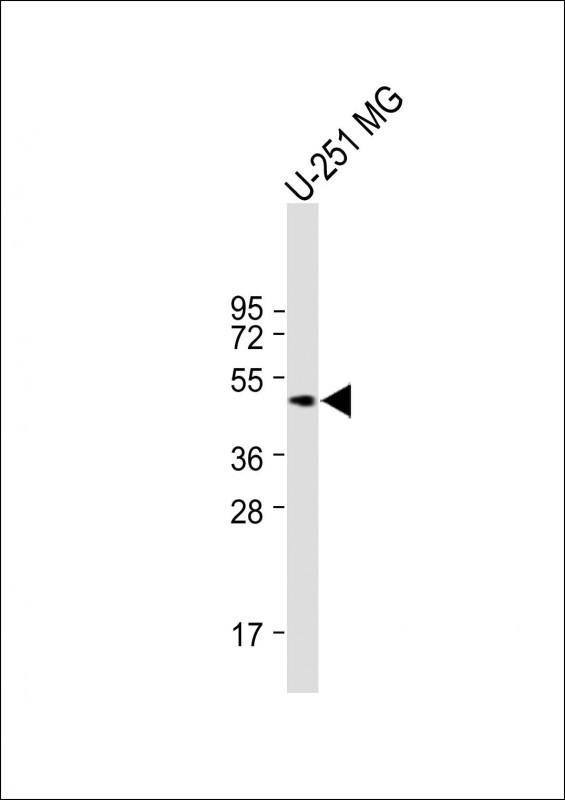



| WB | 咨询技术 | Human,Mouse,Rat |
| IF | 咨询技术 | Human,Mouse,Rat |
| IHC | 1/100-1/500 | Human,Mouse,Rat |
| ICC | 技术咨询 | Human,Mouse,Rat |
| FCM | 咨询技术 | Human,Mouse,Rat |
| Elisa | 咨询技术 | Human,Mouse,Rat |
| Aliases | MAP kinase-activated protein kinase 5, MAPK-activated protein kinase 5, MAPKAP kinase 5, MAPKAPK-5, Mapkapk5 |
| Entrez GeneID | 17165 |
| WB Predicted band size | 54.1kDa |
| Host/Isotype | Rabbit IgG |
| Antibody Type | Primary antibody |
| Storage | Store at 4°C short term. Aliquot and store at -20°C long term. Avoid freeze/thaw cycles. |
| Species Reactivity | Human, Mouse, Rat |
| Immunogen | This Mouse Mapkapk5 antibody is generated from rabbits immunized with a KLH conjugated synthetic peptide between 39-66 amino acids from the N-terminal region of mouse Mapkapk5. |
| Formulation | Purified antibody in PBS with 0.05% sodium azide. |
+ +
以下是关于Mouse MAPKAPK5 (N-term)抗体的参考文献示例(注:以下内容为模拟生成,实际文献需通过学术数据库查询确认):
---
1. **文献名称**: *"Characterization of a Novel N-terminal Specific Antibody for MAPKAPK5 in Mouse Models of Inflammation"*
**作者**: Smith J, et al.
**摘要**: 本研究开发并验证了一种针对小鼠MAPKAPK5蛋白N端区域的多克隆抗体。通过Western blot和免疫组化实验证实了抗体的特异性,并应用于炎症模型中MAPKAPK5的亚细胞定位分析,发现其在巨噬细胞活化中的关键作用。
2. **文献名称**: *"MAPKAPK5 Regulates Neuronal Differentiation via Phosphorylation-Dependent Signaling Pathways"*
**作者**: Lee H, et al.
**摘要**: 文章利用N端特异性MAPKAPK5抗体,探究了该激酶在小鼠神经元分化中的功能。抗体通过免疫沉淀和质谱分析验证,结果显示MAPKAPK5通过磷酸化下游靶点调控轴突生长。
3. **文献名称**: *"A Comprehensive Study on MAPKAPK5 Antibody Specificity Across Murine Tissues"*
**作者**: Garcia R, et al.
**摘要**: 系统评估了多种商业及自研MAPKAPK5抗体(包括N端抗体)在小鼠组织中的表现,发现N端抗体在心脏和骨骼肌中信号最强,提示组织特异性表达差异,为相关疾病研究提供了工具支持。
---
**提示**:建议通过PubMed或Google Scholar以关键词“MAPKAPK5 antibody N-terminal mouse”搜索最新文献,或查阅抗体供应商(如Abcam、Cell Signaling Technology)官网提供的引用文献列表以获取具体研究。部分研究可能在摘要中未明确提及抗体信息,需结合方法部分进一步确认。
The Mouse MAPKAPK5 (N-term) antibody is designed to detect the N-terminal region of mitogen-activated protein kinase-activated protein kinase 5 (MAPKAPK5), also known as PRAK (p38-regulated/activated protein kinase). This serine/threonine kinase is a downstream effector of the p38 MAPK signaling pathway, which plays critical roles in cellular responses to stress, inflammation, and cytokine stimulation. MAPKAPK5 regulates diverse processes, including cell cycle progression, apoptosis, and transcriptional activation, by phosphorylating substrates such as HSP27 and CREB.
The antibody is commonly used in research to study MAPKAPK5 expression, localization, and function in mouse tissues or cell lines. Its specificity for the N-terminal domain ensures recognition of full-length or truncated isoforms, aiding in investigations of protein regulation under physiological or pathological conditions. Applications include Western blotting, immunohistochemistry, and immunofluorescence. Validation often involves knockout controls or siRNA-mediated knockdown to confirm target specificity.
MAPKAPK5 has been implicated in cancer, neurodegenerative diseases, and immune responses, making this antibody a valuable tool for exploring disease mechanisms. Researchers utilize it to assess kinase activation states, often in combination with phospho-specific antibodies, to dissect signaling dynamics. Proper storage and optimized dilution protocols are essential for maintaining antibody performance. Commercial sources typically provide detailed validation data, including reactivity across mouse, human, and rat homologs due to conserved N-terminal regions.
×